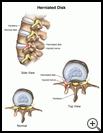
Laminectomy
________________________________________________________________________
KEY POINTS
- A laminectomy is surgery to remove a small piece from the back of one of the bones in your spine.
- A laminectomy is used to treat a disk that has bulged out of place, or pressure on spinal nerves that causes pain, weakness, numbness, or other problems.
- Ask your provider how long it will take to recover and how to take care of yourself at home.
- Make sure you know what symptoms or problems you should watch for and what to do if you have them.
________________________________________________________________________
What is a laminectomy?
A laminectomy is surgery to remove a small piece from the back of one of the bones in your spine. This part of the bone is called the lamina.
When is it used?
The bones of your spine protect your spinal cord, which is a bundle of nerves that runs down the middle of your back. In between the bones are rubbery disks that act as shock absorbers.
A laminectomy is used to treat:
- A herniated disk: A disk that has bulged out from its proper place in your neck or back and presses on nearby nerves.
- Spinal stenosis: A narrowing of spaces between the bones of your spine that puts pressure on the nerves.
A laminectomy may be done when pressure on the spinal nerves causes one or more of these problems:
- Arm or leg pain that limits what you can do
- Weakness or numbness in your arms, hands, legs, or feet
- Problems controlling urine or bowel movements
How do I prepare for this procedure?
- Make plans for your care and recovery after you have the procedure. Find someone to give you a ride home after the procedure. Allow for time to rest and try to find other people to help with your day-to-day tasks while you recover.
- You may or may not need to take your regular medicines the day of the procedure. Tell your healthcare provider about all medicines and supplements that you take. Some products may increase your risk of side effects. Ask your healthcare provider if you need to avoid taking any medicine or supplements before the procedure.
- Tell your healthcare provider if you have any food, medicine, or other allergies such as latex.
- Follow your provider's instructions about not smoking before and after the procedure. Smokers may have more breathing problems during the procedure and heal more slowly. It’s best to quit 6 to 8 weeks before surgery.
- Your healthcare provider will tell you when to stop eating and drinking before the procedure. This helps to keep you from vomiting during the procedure. Tell your healthcare provider if you have any food or medicine allergies.
- Follow any other instructions your healthcare provider gives you.
- Ask any questions you have before the procedure. You should understand what your healthcare provider is going to do. You have the right to make decisions about your healthcare and to give permission for any tests or procedures.
What happens during the procedure?
You will be given a regional or general anesthetic to keep you from feeling pain. Regional anesthesia numbs part of your body while you stay awake. If you have regional anesthesia, you may also be given medicine to help you relax. General anesthesia relaxes your muscles and puts you into a deep sleep.
Guided by the X-ray tests you have had, your healthcare provider will make a cut and remove a small part of the bone over the area where the nerve is pinched. Your healthcare provider will then remove the bulging part of the disk or give the nerve more space, repair the layers of tissue that have been cut, and close the wound.
What happens after the procedure?
You may go home later in the day, or you may need to stay in the hospital for a couple of days, depending on your condition.
Follow your healthcare provider's instructions. Ask your provider:
- How long it will take to recover
- How you can take the best care of your back
- If there are activities you should avoid and when you can return to your normal activities
- What exercises you should do to strengthen your back
- How to take care of yourself at home
- What symptoms or problems you should watch for and what to do if you have them
Make sure you know when you should come back for a checkup. Keep all appointments for provider visits or tests.
What are the risks of this procedure?
Every procedure or treatment has risks. Some possible risks of this procedure include:
- You may have problems with anesthesia.
- You may have infection or bleeding.
- Other parts of your body may be injured during the surgery.
- The surgery may not relieve your pain. It may even be worse after surgery.
Ask your provider how these risks apply to you. Be sure to discuss any other questions or concerns that you may have.

